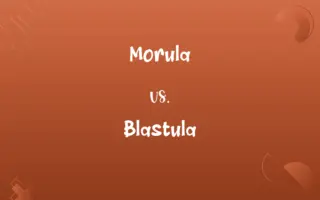Rate of Reaction vs. Rate Constant: Know the Difference

By Shumaila Saeed || Updated on December 25, 2023
Rate of Reaction measures how fast reactants turn into products, while Rate Constant is a proportionality factor in the rate equation, reflecting reaction conditions.

Key Differences
Rate of Reaction refers to the speed at which reactants are converted into products in a chemical reaction. It can vary based on factors like concentration, temperature, and the presence of catalysts. On the other hand, the Rate Constant is a specific value in the rate equation of a chemical reaction. It is a numerical value that remains constant for a given reaction at a fixed temperature, symbolizing the inherent speed of the reaction.
Shumaila Saeed
Dec 08, 2023
The Rate of Reaction is expressed in terms of concentration change per unit time, such as moles per liter per second. It gives a real-time insight into the dynamics of a chemical process. Conversely, the Rate Constant is a coefficient that relates the rate of reaction to the concentrations of reactants in the rate law equation. It does not change with concentration but may vary with temperature and the nature of the reaction.
Shumaila Saeed
Dec 08, 2023
In practical terms, the Rate of Reaction is what chemists observe and measure during experiments. It is an observable and variable attribute, directly influenced by external conditions. In contrast, the Rate Constant provides a theoretical framework for understanding these observations. It is an intrinsic property of a reaction, independent of initial concentrations, yet sensitive to environmental changes like temperature.
Shumaila Saeed
Dec 08, 2023
Analyzing the Rate of Reaction helps in understanding the efficiency and feasibility of industrial processes. It is crucial in the design and control of chemical reactors. Meanwhile, knowledge of the Rate Constant is essential for predicting the behavior of reactions under different conditions, crucial for theoretical modeling and chemical kinetics studies.
Shumaila Saeed
Dec 08, 2023
Overall, while the Rate of Reaction is a practical, variable measure of how fast a reaction proceeds, the Rate Constant is a fixed parameter that defines the relationship between reaction rate and reactant concentrations under specific conditions.
Shumaila Saeed
Dec 08, 2023
ADVERTISEMENT
Comparison Chart
Definition
Speed of reactants turning into products
Proportionality factor in rate equation
Shumaila Saeed
Dec 08, 2023
Units
Molarity per time (e.g., M/s)
Depends on reaction order (e.g., s⁻¹ for first-order)
Shumaila Saeed
Dec 08, 2023
Variability
Changes with conditions like concentration
Constant for a given reaction at a fixed temperature
Shumaila Saeed
Dec 08, 2023
Observability
Directly measurable in experiments
Calculated from reaction kinetics data
Shumaila Saeed
Dec 08, 2023
Dependency
Dependent on external factors (concentration, catalysts)
Dependent on intrinsic reaction properties and temperature
Shumaila Saeed
Dec 08, 2023
ADVERTISEMENT
Rate of Reaction and Rate Constant Definitions
Rate of Reaction
Measure of speed for a chemical reaction.
The rate of reaction in combustion is extremely fast.
Shumaila Saeed
Dec 01, 2023
Rate Constant
Fixed parameter for a chemical reaction under specific conditions.
The Arrhenius equation relates temperature to the rate constant of a reaction.
Shumaila Saeed
Dec 01, 2023
Rate of Reaction
Rate at which reactants convert to products.
In a rapidly fizzing antacid tablet, the rate of reaction is high.
Shumaila Saeed
Dec 01, 2023
Rate Constant
Invariant factor in a reaction's rate equation.
The rate constant remains the same for a given reaction at constant temperature.
Shumaila Saeed
Dec 01, 2023
Rate of Reaction
Quantitative expression of reactant consumption over time.
A slow rate of reaction is observed in rusting of iron.
Shumaila Saeed
Dec 01, 2023
ADVERTISEMENT
Rate Constant
Temperature-dependent constant in kinetics.
The rate constant changes when the reaction temperature is altered.
Shumaila Saeed
Dec 01, 2023
Rate of Reaction
Variable rate dependent on reaction conditions.
Adding a catalyst boosted the rate of reaction in the decomposition of hydrogen peroxide.
Shumaila Saeed
Dec 01, 2023
Rate Constant
Constant value representing reaction speed in rate law.
A large rate constant indicates a faster chemical reaction.
Shumaila Saeed
Dec 01, 2023
Rate of Reaction
Indicator of how quickly a reaction proceeds.
A higher temperature usually increases the rate of reaction.
Shumaila Saeed
Dec 01, 2023
Rate Constant
Numerical coefficient linking reaction rate to reactant concentrations.
In first-order reactions, the rate constant helps predict the reaction's half-life.
Shumaila Saeed
Dec 01, 2023
Repeatedly Asked Queries
Can the rate of reaction be directly measured?
Yes, it can be measured by observing the change in reactant or product concentrations over time.
Shumaila Saeed
Dec 08, 2023
Does temperature affect the rate constant?
Yes, the rate constant typically changes with temperature.
Shumaila Saeed
Dec 08, 2023
Is the rate constant affected by reactant concentration?
No, the rate constant remains the same regardless of concentration changes.
Shumaila Saeed
Dec 08, 2023
Can the rate constant be used to predict reaction behavior?
Yes, it's used in theoretical models to predict how reactions will behave under different conditions.
Shumaila Saeed
Dec 08, 2023
How is the rate of reaction important in industry?
It's crucial for designing and controlling chemical reactors and processes.
Shumaila Saeed
Dec 08, 2023
Are catalysts affecting the rate of reaction?
Yes, catalysts can significantly increase the rate of reaction.
Shumaila Saeed
Dec 08, 2023
What does the rate of reaction indicate?
It indicates the speed at which reactants are converted to products.
Shumaila Saeed
Dec 08, 2023
What unit is the rate of reaction expressed in?
It's often expressed in moles per liter per second (M/s).
Shumaila Saeed
Dec 08, 2023
Does the rate of reaction change in the course of the reaction?
Yes, it can change as reactants are consumed and conditions vary.
Shumaila Saeed
Dec 08, 2023
Does the rate constant differ for different reactions?
Yes, each reaction has its unique rate constant under given conditions.
Shumaila Saeed
Dec 08, 2023
Is it possible to have a zero rate constant?
Theoretically, a zero rate constant would mean the reaction does not proceed under those conditions.
Shumaila Saeed
Dec 08, 2023
How does particle size affect the rate of reaction?
Smaller particle sizes generally increase the rate of reaction due to greater surface area.
Shumaila Saeed
Dec 08, 2023
What role does the rate of reaction play in environmental chemistry?
It helps in understanding and predicting the behavior of pollutants and their breakdown.
Shumaila Saeed
Dec 08, 2023
Can we determine the mechanism of a reaction from its rate constant?
While the rate constant provides insights, it alone is not sufficient to determine the exact mechanism.
Shumaila Saeed
Dec 08, 2023
Is the rate constant a direct observable quantity?
No, it's typically calculated from experimental data.
Shumaila Saeed
Dec 08, 2023
Can the rate of reaction be manipulated for faster production?
Yes, by altering conditions like temperature, pressure, or adding catalysts.
Shumaila Saeed
Dec 08, 2023
How is the rate of reaction useful in pharmaceuticals?
It aids in developing efficient drug synthesis and degradation processes.
Shumaila Saeed
Dec 08, 2023
What does a high rate constant signify?
It signifies a faster reaction under given conditions.
Shumaila Saeed
Dec 08, 2023
Can the rate constant be determined from a single experiment?
Often, multiple experiments are needed to accurately determine the rate constant.
Shumaila Saeed
Dec 08, 2023
Is the rate constant always a fixed value?
It's fixed for a given reaction at a specific temperature but varies with different reactions or temperatures.
Shumaila Saeed
Dec 08, 2023
Share this page
Link for your blog / website
HTML
Link to share via messenger
About Author
Written by
Shumaila SaeedShumaila Saeed, an expert content creator with 6 years of experience, specializes in distilling complex topics into easily digestible comparisons, shining a light on the nuances that both inform and educate readers with clarity and accuracy.









































































